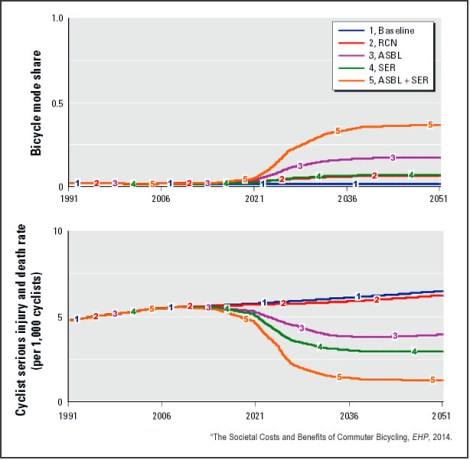Next time you hop on your bike, give yourself a pat on the back for being such a model citizen. Not only are you about to get some fresh air and exercise, you are going to save your city some serious dough.
According to a study from Environmental Health Perspectives, cycling infrastructure is a smart investment for penny-pinching city planners. Taking the city of Auckland in New Zealand as a test case, the researchers looked at simulations of different biking scenarios: a shared-road bike lane network, separated arteries of bike lanes on all main roads, something called “self-explaining roads” with car-slowing design elements, as well as a sweet-spot combination of those separated lanes and self-explaining elements.
In every scenario, between $6 and $24 were saved for every dollar spent, compared to a business-as-usual baseline. How, you ask? In addition to the pollution, traffic congestion, and sedentary-lifestyle health problems associated with cars, society bears the brunt of our automobile addiction in the form of medical and emergency services. That car crash is, yes, tragic, but it is also expensive.
Here are five big takeaways from the study:
1. When more people start to bike, there are fewer cars on the road. So while you are bound to have more bike fatalities by number, the actual rate of injury per biker goes down. Meanwhile, car-related fatalities drop by enough to cancel out the cycling casualties two or three times over.

Macmillan et al.As bike injuries increase, total fatalities decrease overall. Click to embiggen.
2. It’s cheaper to build bike lanes on top of existing infrastructure, but you get what you pay for. The leanest bike budget could carve some lanes out of existing road surface, but in that scenario, biking’s share of overall trips only increases from 1 to 5 percent, while car trips hold steady — meaning so do all automotive social ills.
3. If you build it, they will come. Separated bike lanes along all major carways caused cycling traffic to spike to 20 percent. And while it wasn’t the safest option, the rate of injury was still almost half of what it was sans-barrier.
4. Slowing down cars makes everyone breathe a little easier. The self-explaining roads led to the greatest decrease in air pollution, and the safest situation for bicyclists. The death and injury rate was cut in half, while cars’ share of road trips dropped to 55 percent.
5. The best of both worlds is usually the best. Traffic-calming road design and separated bike lanes are the peanut butter and chocolate of the urban planning world. Car use dropped to 40 percent of all traffic, while, in karmically perfect sync, biking rose to 40 percent. Meanwhile, there were 4,000 fewer deaths from lack of physical activity — a much greater risk than pedal-pushing.
Oh yeah. And that last option also had the greatest return on investment of them all: $24 in the bank for every one spent on bikes.


